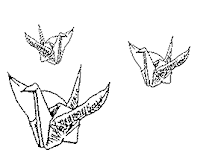
Joey and I joined a group of homeschoolers and other school children on Friday, to watch the a Honolulu Theater for Youth production. It was called A Thousand Cranes.
The story is about a young girl in Japan named Sadako. When she was 2 years old, the bomb fell on her hometown of Hiroshima killing her grandmother, along with thousands of other people. When Sadako was 12, she fell during a race. At the hospital, she was diagnosed with leukemia. As you can imagine, Sadako and her parents were devastated by this news.
Her good friend shared with Sadako a way she could get well. He told gave her a paper crane, created with origami, and told her that when she completed the thousandth paper crane, she would be well.
Sadako begins to fold her paper cranes but she dies a little past the middle of her goal.
This is a beautiful story based on a true story of a little girl in Japan during World War II.
What makes the story even more touching is that Sadako's classmates end up finishing the 1000 cranes for Sadako, even after her death.
In commemoration of the bombings, a peace park was founded in Himoshima. There stands a statue of Sadako with her hands outstretched holding a golden crane. The base of her statue reads:
This is our cry.
This is our prayer.
Peace in the world.
Children all over the world send their paper cranes to the park as a way of honoring this courgeous young girl.
This play was presented with a cast of three. It was done using Japanese artistic forms of masks, Butoh Dance, lighting, etc.
The following is from director Reiko Ho:
"A Thousand Cranes is a play about ghosts--the spirts and memories of Sadako and those who were affected by the tragic bombing of Hiroshima. It is a play about connecting to the past in order to see the present more clearly. Why is Sadako's story told throughout the world? It reminds us that children are most often the innocent victims of war and of the continuing need for 'peace in the world.' The play consists of Sadako's memories and her eventual passing from life to death.
The actors become numerous characters, melting from one to another in Sadako's stream of consciousness, which culminates in Sadako's retun as a spirit to tell her own story."
If you would like to learn how to make a paper crane, please check out Making a Paper Crane Video
Once you create your paper cranes, you can send them to the Peace Park:
Office of the Mayor
City of Hiroshima
6-34 Kokutaiki-Machi
1 Chome Naka-ku, Hiroshima 730, Japan
Recommended Reading:
Besides the books based on Sadako's story, you may be interested in reading A Song for Nagasaki by Paul Glynn.
"A Song for Nagasaki is the story of Takashi Nagai, M.D., pioneer professor of radiology at the University of Nagasaki, who died of atomic disease six years after the second atomic bomb incinerated his wife and home. It is also the story of his spiritual pilgrimage from his native Shintoism to atheistic rationalism and then to a rationalist complacency disturbed by Pascal's Pensees. His heart, convinced by the fervor of the family he boarded with, converted to a lively Christian faith..."

No comments:
Post a Comment